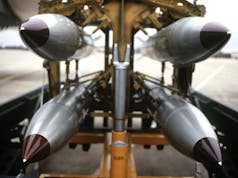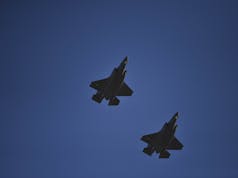The U.S. Air Force has selected JetZero for the next phase of a blended wing body prototype aircraft project.
The effort, according to the USAF, aims to mature BWB technology and demonstrate its capabilities, giving the department and commercial industry more options for future air platforms.
“With a design that differs from a traditional tube-and-wing aircraft, the BWB blends the aircraft body into its high-aspect-ratio wing, decreasing aerodynamic drag by at least 30% and providing additional lift. This increased efficiency will enable extended range, more loiter time, and increased payload delivery efficiencies, capabilities that are vital to mitigating logistics risks.”
Several military transport configurations are possible with the BWB. Together, these aircraft types account for approximately 60% of the Air Force’s total annual jet fuel consumption.
“Blended wing body aircraft have the potential to significantly reduce fuel demand and increase global reach,” said Secretary of the Air Force Frank Kendall.
“Moving forces and cargo quickly, efficiently, and over long distance is a critical capability to enable national security strategy.”
The Air Force Operational Energy Office expects completion of initial flight testing as early as 2027.
While the BWB concept has been around for decades, more recent technology advancements in structural design, materials technology, manufacturing, and other areas have made large-scale production achievable, you can read more here.














The radar return on those engines would be fully Russian style? Lots of metal exposed…..
It’s a transport. Compare it to a C-17 or an Atlas and it looks a lot better, right?
Surely that’s why they are on top. As a transport that’s probably considered a fair trad off that wouldn’t be on a frontline strike aircraft.
SF insertions?
From the same height and above of the aircraft you are right, but stealth is compromised by airborne radar platforms such as E3 and E7. From the ground the engines are hidden. A similar approach is used on A10 Warthog.
Looks like a very worthwhile project to replace C17. I wonder if it would be a good stand-off arsenal plane. (i.e. targetting from F35/Typhoon and weapon launch from BLB platform).
From the frontal aspect the engines will be shielded from ground based radar. There is another design that they did, that had the engines semi-embedded in the rear upper fuselage, which would give a better reduced radar signature. But as this is a proof of concept program. Hopefully it will be more than just a small scale model.
It’s a concept that should have been pushed more by UK Government and Industry, since Cranfield University collaborated their design with Boeing. Yet again, another wasted opportunity!
I agree, we should at least have a research institute as Farnborough once was. Presumably closed due to EU anti-competition and unfair subsidy rules. Now we have cast off the EU anchor; all of the Guilt Aid to India can help pay for it. Countries that thrive do it well viz S. Korea, Japan, Israel. We should strive to emmulate those places with their energy and productivity.
The War Zone also covers this, which is worth a read. https://www.thedrive.com/the-war-zone/blended-wing-body-demonstrator-jet-contract-has-been-awarded-by-air-force
A lifting body I believe. The X-48B concept was similar. The scale model built here in the UK.
OTT and I don’t mean to be controversial. Aust news today is saying that the 200+ Tomahawks for the RAN are going to be for the AAW Hobart’s MK41s first up. And I think some for the Collins subs and T26 Hunter’s later on. Wonder if the UK will also be ordering any, anymore for the T26/31s as an interim before the FC/ASW? Any possibility for MK41s onto the T45s? And any more of the sub variant for the Astute’s? All at bargain prices while stocks last! 😁
The space that was once allocated for Mk41’s has been taken up with the additional SAM fit that they will get so no space left. At least they are getting some attack missiles from Norway to help balance them up.
I highly doubt they’ll get Tomahawk for Type 31 / 26’s because FC/ASW is supposed to enter service in 2028 not long after HMS Glasgow and HMS Venturer enter service in 2027. There is little point in buying a suitable interim stockpile of VL-Tomahawks for the first few ships of either class when a permanent solution is only a year away.
Good evening Sir Jack!, let’s hope they’re no delay’s with the FC/ASW or any broader new conflict in the mean time. It will be interesting what one or mix of FC/ASW the RN goes with as I believe there’re two variants, one supersonic, one subsonic. I’m not sure if there’ll be a sub launched variant, but I imagine with the AUKUS SSNRs there’ll be sub specific missiles for their VLS.
I would have preferred Mk41s were added to the Type 45 as it would increase flexibility and give commanders more options. That said, I am a realist and I understand the RN only has finite resources. The addition of 24 x CAMM and 8 x NSM, is a good compromise. Also, the updates coming to SAMPSON, etc., mean the Type 45s will be a formidable platform for a long time to come (my only gripe is we only have 6 of them but that is a whole other conversation).
Considering the plans for the Type 45 and the fact that Mk41 will now be fitted the Type 31 (increasing the lethality of this class significantly!), is something I can live with and represents the best we can expect under the current funding available.
Definitely worth us getting involved at an early stage- our C-17s are worth their strategic weight in gold and they won’t last forever. Would be criminal if they were retired without replacement.
Looking at the picture, I’m surprised that Boeing and Airbus aren’t looking at this for commercial airliners (or maybe they are?). Looks ideal for that purpose – more efficient and loads more space…
Not really viable for commercial operations as thing stands. Airport infrastructure would have to change to accommodate the aircraft type which would cost a fortune. I think we’ll see wing truss structures on commercial aircraft before a blended wing.
They also don’t have the best flight experience for passengers.
Anything other than straight line flight, movement is exaggerated due to the wide spread of payload, i.e.: passenger seats. Any turn results in a much greater movement for the passenger on both sides of the body of the plane.
Additionally they are not the most stable, which is fine for a fast jet, but not a commercial airliner.
Lastly they would tend to be really large capacity and after the A380 there appears little appetite to develop that sort of size.
Be interesting to see how it develops, not least as there is no replacement for the C17 yet and none have been built since 2015.
There have been plans to have a hybrid layout, where a passenger cabin is fitted down the centre, even one with a double decker layout. There would be no windows, just screens displaying the outside. With cargo then sitting either side of it. Not a great idea if the weight distribution is off. Plus passenger’s aren’t really that heavy so the balance factor would need to be compensated for by the flight control software. Which in today’s World is more than doable.
Flight stability of a BWB is not such a great issue as modern fly by wire flight controls along with the digital flight computer can compensate for the stability.
I do agree that BWB should be the evolutionary step in aircraft design.
Makes you realise that Thunderbirds programme was bang on in terms of future tech.
Vertical launch and recovery for rockets- Tesla nailed that.
Blended wing design- pending.
👀😬
Didn’t someone else do this first? Oh that’s right, Avro then Hawker Siddeley who made… that’s right you guessed it… the Avro Vulcan, which first flew in 1952.
I wish the RAF still had a strategic bomber capability even if it was just to haul a dozen cruise missiles to within firing range would be a great capability to have.
I see the Japanese are investigating turning the entirety of their transport fleet into cruise missile mules in an effort to deliver a real saturation strike capability that could potentially close the Taiwan straight.
In my humble opinion, the worst thing that ever happened to British design and ingenuity, was the amalgamation of dozens of ‘smaller’ aircraft design and manufacturers.
All those different people, working in all those different company’s, with all those different designs and ideas.
Where are the Barnes Wallis’s, the Mitchell’s, De Havilland’s, Sopwith’s, Fairey, Blackburn, Roe’s, Camm’s, Folland’s in the 21 century?
When you kill off all that competitiveness as was pretty much the case by the 1960’s and 1970’s, you ultimately lose the inventive ‘spirit’ of the individual, confining them to the limitations or restrictions, of multi million pound corporations.
I say corporations, as they and their shareholders, are the ones who set their business goals, objectives and modus operandi.
I agree but though small may be beautiful, economic it ain’t, unless you subsidise design bureau via say, the universities.
The best hope now is to get Britain Norman going and make some really great combat drones; something the Carriers could do with yesterday.
In about 1966 I went to a Barnes Wallis lecture featuring the swing wing Swallow. He was rubbishing the Tornado then in design.
Reminds me a bit of Thunderbird Two.
Looks like a copy of the Airbus Maveric a scale model of it has already flown